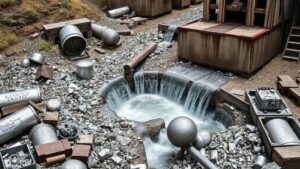Evaluating Old Ore Dumps for High-Grade Silver Residues
Evaluating Old Ore Dumps for High-Grade Silver Residues
The assessment of old ore dumps for high-grade silver residues presents a compelling opportunity for mineral exploration. Such dumps, often overlooked or deemed economically unviable, can harbor significant amounts of precious metals. This article aims to outline the methodologies, challenges, and case studies involved in evaluating these deposits, with a particular focus on silver recovery.
The Importance of Silver Recovery
Silver is a valuable commodity, used extensively in various industries including electronics, photovoltaics, and jewelry. According to the Silver Institute, global silver demand was estimated at 1.05 billion ounces in 2022. With prices hovering around $25 per ounce, the financial viability of extracting silver from old ore dumps becomes increasingly appealing.
Evaluating old ore dumps involves a variety of techniques and analytical methods that can effectively ascertain the presence of high-grade silver. The following are commonly employed methodologies:
- Sampling and Assaying: Systematic sampling is crucial for obtaining representative data. Samples are typically taken at regular intervals, with each assayed for silver content to establish a baseline grade.
- Geochemical Analysis: Techniques such as X-ray fluorescence (XRF) and atomic absorption spectroscopy (AAS) can provide detailed composition data, allowing for an accurate assessment of silver concentrations.
- Geophysical Surveys: Methods like electromagnetic (EM) and resistivity surveying help identify areas of higher mineralization, guiding further exploration efforts.
Case Study: The Comstock Lode
The Comstock Lode, located in Nevada, is one of the most famous silver mining districts in U.S. history. After extensive mining between the mid-19th century and the early 20th century, significant amounts of ore were left in surface dumps. Modern geochemical techniques reassessing these dumps revealed assays showing silver grades as high as 15 ounces per ton, prompting renewed interest in recovery.
This case exemplifies how historical data combined with modern technology can elevate the economic feasibility of previously abandoned sites.
Challenges of Evaluating Old Ore Dumps
While the potential for recovering high-grade silver exists, several challenges must be traversed:
- Environmental Concerns: The evaluation and extraction process may disturb ecosystems, necessitating detailed environmental impact assessments.
- Regulatory Hurdles: Permitting processes for exploration and recovery can be complex. Mines may be held to strict standards regarding waste management and pollution control.
- Market Volatility: The price of silver fluctuates, which can affect the economic viability of recovery projects. In the short term, prices may not justify extraction costs.
Real-World Applications and Future Directions
The techniques discussed can be applied not only to silver but also to other metals, including gold and copper. Companies like Barrick Gold and Hecla Mining are already investing in research to unlock the value of old dumps using innovative processing methods.
As technology advances, particularly in data analytics and geochemical analysis, the potential for new discoveries in old ore dumps will likely increase, making this an area of continuous exploration and development.
Actionable Takeaways
- Consider the geological history and background of ore dumps before evaluation.
- Use a combination of sampling, assay techniques, and modern technology for effective analysis.
- Be aware of environmental regulations and conduct thorough impact assessments.
- Stay informed on silver market trends to align exploration efforts with economic viability.
Evaluating old ore dumps for high-grade silver residues is not only a viable enterprise; it represents a sustainable approach to resource recovery, maximizing the use of existing materials while minimizing environmental impact. Through focused methodologies and an understanding of the inherent challenges, significant opportunities remain in this underexplored field.


